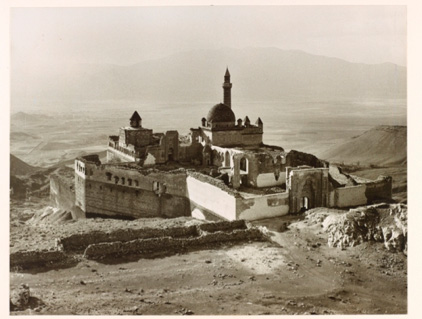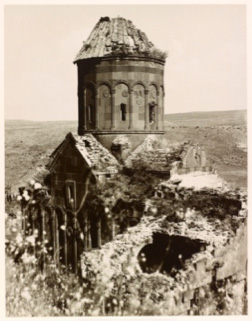Putting Turkish Photojournalist Ara Güler into Focus

Raymond Hare, U.S. ambassador, 1961–65, stands at left in front of the Church of Agh’tamar Van with an unidentified man and James P. Grant, mission director of USAID to Turkey, 1964–67, on the right. This image was included in the portfolio of photographs by Ara Güler that Hare donated to the Freer|Sackler in 1989.
For the Freer and Sackler Galleries’ first-ever student-curated exhibition, undergraduates at Johns Hopkins University researched a collection of photographs by famous Turkish photographer Ara Güler held in the museums’ archives. Nancy Micklewright, head of scholarly publications and programs at the Freer|Sackler, taught the students in a Hopkins Museums and Society practicum course aimed at developing this exhibition. Derived from the class’s original plans, In Focus: Ara Güler’s Anatolia (on view December 14, 2013–July 20, 2014) introduced the field of photojournalism, as well as living photojournalist Ara Güler and his strong opinions about art and documentation. Playing off of the experimental nature of the course, student curators brought the Freer|Sackler a nontraditional exhibition that asked viewers to engage with the collection, thinking about whether photographs qualify as art, document—as Güler claims—or a complex mixture of the two.
The Collection
The collection of Güler photographs that the students worked with was donated to the Freer|Sackler Archives in 1989 by former U.S. Ambassador to Turkey Raymond A. Hare (1901–1994). Hare first lived in Turkey from 1924 to 1927, when he developed a love for Middle Eastern architecture, such as the medieval Seljuk and Armenian monuments depicted in the collection’s photographs. Hare’s colleagues gave him the photographs in 1965, when he completed his term as ambassador, and wished him good memories of the country in the collection’s dedication.
Photographs on the Edge at Johns Hopkins University

Construction of the Ishak Pasha Palace of Dogubeyazit, Turkey, was finished in 1784. It is the newest monument featured in the Hare collection. Used as an Ottoman administrative complex, the fortress was damaged in many wars due to its proximity to the Russian and Persian borders of the Ottoman Empire.
Sharing Hare’s love for Islamic architecture, Micklewright has studied and visited the majority of the monuments pictured in Güler’s images. Her expertise in Islamic architecture and photo history as well as her background in teaching made her an ideal candidate to collaborate with the JHU Program in Museums and Society for the practicum course. However, while Micklewright has taught curatorial-based classes before, her job at the Smithsonian focuses primarily on scholarly publications and programming, not curating exhibitions. In this sense, the Hopkins class began as an experimental endeavor, with both teacher and students approaching the project as a learning process.
Funded by the Andrew W. Mellon Foundation, Micklewright’s class, “Photographs on the Edge: Ara Güler in the Archives of the Smithsonian’s Freer and Sackler Galleries” (January–May 2013), gave students the rare chance to curate alongside Smithsonian staff, splitting class time between Hopkins’ Homewood campus and the Freer|Sackler Archives.

A group of undergraduate students looks at selections of Güler’s photographs in the Freer|Sackler Archives to develop their exhibition proposals.
In the first half of the semester, students formed three groups to produce exhibition proposals. They researched the collection’s historical background, subject matter, and creator (Ara Güler), expanding upon the topics they found most interesting. They also developed ideas about how to design a gallery layout, approach audiences, and use wall text in the space. In order to generate and later refine their ideas, the class took several trips to the Freer|Sackler Archives, where they examined Güler’s images and compiled selections.
The open-ended nature of the curatorial assignment ultimately led to three compelling exhibition concepts. The first focused on the political and religious nature of Güler’s images of Akdamar Island, the site of an Armenian church built in 922 CE. The second proposal attempted to replicate Güler’s travels throughout Anatolia, moving geographically through the 10th–12th-century Armenian ruin sites found in his photographs. Finally, the third proposal focused on Güler’s assertion that he is a photojournalist, not an artist, and his belief that there is a distinct boundary between these fields.
After presenting these proposals, the class decided to continue to develop the third concept, centered on Ara Güler and the debate between photojournalism and art. While historically intriguing, the first and second proposals employed Güler’s photographs to talk about the architecture of depicted buildings instead of examining the photographs themselves. The class chose to work on a project focusing on the photographer, provoking visitors to look at photographic elements such as vantage point, lighting, framing, etc., in order to determine whether photographs qualify as art or document. This curatorial approach provided the JHU class with a way to present something unusual and interactive to the public, aiming to enhance visitors’ visual literacy.
For the second half of the semester, students broke up into three new groups to work on social media plans, public programming, and wall text. By the end of the semester, the Hopkins students had developed a full exhibition plan, ready for further development by professional staff.
Curating at the Freer|Sackler

Detail of the façade of Ulu Cami Divrigi. In the exhibition, student curators ask, “Does this photo qualify as pure documentation, as Güler says it does, or can it also qualify as art?”
When the semester ended, two students were selected to continue the work of the class as interns at the Freer and Sackler Galleries. These interns, Christie YoungSmith and Grace Golden, worked throughout the summer to further the class’s concept and to complete initial curatorial work. They began by compiling extensive bibliographies on Güler and photojournalism, reading books, articles, and essays and watching interviews in order to learn more about his stance on photojournalism and art. From there, the interns spent more time in the museums’ archives, meeting with curators to help finalize the image selection.
Their first goal was to determine how to make the Güler exhibition look and feel distinct from the museums’ typical shows, in order to reflect its unorthodox development. But how do curators make an exhibition look and feel different? Micklewright and the Johns Hopkins interns decided to employ a strong curatorial voice in the wall text as a way to showcase the exhibition’s distinctiveness, directing viewers to look closely at the images and draw their own conclusions about photographs as document or art.
YoungSmith and Golden also spent time brainstorming how visitors could publicly express their opinions about the debate between documentation and art, thereby enhancing their experience of the exhibition material. With help from the Education Department and Nancy Eickel, a Freer|Sackler editor, the interns discovered that referring back to the debate about whether photographs are document or art made the discussion significant. The interns wondered: When we use cell phone cameras today, posting quick snapshots to Facebook or Instagram, do we act as photojournalists or artists?
Beyond pondering the answer to this debate and figuring out how to ask such questions in wall text, YoungSmith and Golden spent a considerable amount of time writing posts for the Freer|Sackler’s Bento blog. These posts cover topics beyond those presented in the gallery space, investigating subjects ranging from the history of the F|S Archives to Turkish current events.
Exhibition Opens

Church of St. Gregory the Illuminator
In Focus: Ara Güler’s Anatolia opened to the public on December 14, 2013, and was on view through July 20, 2014. During this seven-month period, the exhibition was accompanied by extensive programming. The Freer|Sackler presented talks by Ipek Türeli, Scott Redford, and Klaus Schmidt; a ModernWorks Ensemble concert with an outstanding modern dance performance by Nejla Yatkın; and a film screening of acclaimed Turkish director Nuri Bilge Ceylan’s Once Upon a Time in Anatolia.
The organizers of the exhibition are very happy with the attention it received from both the public and the media. Reviews were mostly positive, encouraging the work of the young students and the Freer|Sackler’s collaboration with the university. The students’ distinct curatorial voice was appreciated by some and criticized by others, who expressed their desire to see more information on the sites depicted in the photographs. There were, of course, people who wished the exhibition had included many more photographs by Ara Güler, especially the black-and-white Istanbul photographs for which he is so well known.
Overall, the collaboration between Freer|Sackler staff and Johns Hopkins University students was a truly extraordinary experience for both parties. By extensively researching and then deciding how to explain, organize, display, and market an exhibition of an archival collection, the Hopkins students got a first-hand look into what curating at the Smithsonian is like. Staff and students learned a lot from each other, as well as from visitors and the scholars and artists who participated in related programs. The Freer|Sackler looks forward to future collaborative projects with young students.
Conservation & Scientific Research
Fellowships & Internships
Scholarly Programs
Resources For Researchers
Publications
More Research Projects
The Paul Singer Collection
Iran in Photographs
Chigusa and the Art of Tea
Islamic Works on Paper
The Pulverer Project
